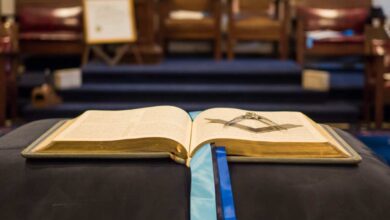How Did the Titanic Sink?
 The maiden voyage of the RMS Titanic set sail on April 10, 1912, but just five short days later the passenger liner met her fate. The fate of the Titanic is well known by everyone who has heard the liner’s name, but few people know exactly what transpired to make the Titanic sink. Below we will take a look at the journey of this Olympic-class ocean liner and just how she landed herself at the bottom of the North Atlantic Ocean.
The maiden voyage of the RMS Titanic set sail on April 10, 1912, but just five short days later the passenger liner met her fate. The fate of the Titanic is well known by everyone who has heard the liner’s name, but few people know exactly what transpired to make the Titanic sink. Below we will take a look at the journey of this Olympic-class ocean liner and just how she landed herself at the bottom of the North Atlantic Ocean.
The Building of the Titanic
Three Olympic Sized Liners Were Commissioned
The Titanic was the second built of three Olympic class ocean liners commissioned and built in Belfast, Ireland. The liners were built for the British shipping company White Star Line and were to go down in record for being the largest ocean liners in the company’s fleet. Discussions for the three liners: the RMS Titanic, the RMS Olympic and the HMHS Britannic were first brought to life in a discussion that took place in mid 1907. When the White Star Line’s chairman and the White Star Line’s parent company’s chief financier got together they were intent on out doing the company’s chief competition Cunard. Cunard had just launched two giant ships: the Lusitania and the Mauretania. Determined to one up the competition, the White Star Line sought to replace their two oldest ships with the Titanic and the Olympic. The building of the three giant ocean liners was contracted to Harland and Wolff, a Belfast ship building company. Harland and Wolff were given a significant amount of freedom as to the design of the ships and told to spend what they needed to get the ships built. The total cost for the building of the first two Olympic classed ships was £3 million (more than $4.6 million) plus additional contracting costs and a five percent fee.
The Dimensions of the Titanic
The dimensions of all three ships commissioned by the White Star Line were mind blowing. Never before had ship builders attempted to create such significant vessels. So large were the vessels that new slip ways had to be built to hold the huge liners as they were being built. Both the Olympic and the Titanic were built in unison in the two slip ways with the hull of the Olympic going down in early December 1908, and Titanic’s hull going down in early March, 1909. The RMS Titanic was to be 882 feet and 9 inches long and have a maximum breadth of 92 feet and 6 inches. From the base of the keel to the top of the bridge, the Titanic measured 104 feet tall. In total the Titanic tipped the scales at 46,328 gross register tons. There were ten decks in total; eight of these were for passengers to use.
The Decks of the Titanic
Top Deck
The top most deck of the Titanic was the Boat Deck. The Boat Deck held the lifeboats and the forward end of this deck held the wheelhouse and the bridge. The middle of the top deck featured the entrance to the first class grand staircase, gymnasium and the roof of the first class lounge. The rear of the deck featured the second class entrance and the room of the first class smoke room. The sides of the ship were lined with lifeboats for the length of the ship with the exception of the first class area. Unfortunately, builders deemed it necessary to remove the lifeboats from the first class area because they might spoil the view.
The A Deck
The A deck or the “promenade deck” featured first class cabins, the first class lounge, reading rooms, writing rooms, a palm court and a smoke room all reserved for first class use.
The B Deck
The B deck was the top level of the ship’s hull. This top weight bearing deck featured first class staterooms with private promenade. Also featured on this deck were: the A La Carte Restaurant, the Café Parisien, the second class smoking room and entrance hall and the third class promenade.
The C Deck
The C deck or the “shelter deck” was the highest uninterrupted deck of the ship. This deck featured a third class promenade, crew cabins, third class public rooms, a second class library and most of the first class cabins.
The D Deck
The D deck or the “saloon deck” featured the first class reception room, the first class dining saloon and the second class dining saloon. Third class passengers simply had an open space. All three classes of passengers could stay on this deck. Firemen were also located on this deck. The watertight bulkheads only reached to this level of the ship.
The E Deck
The E deck or the “upper deck” was used for all classes of passengers as well as berths for stewards, seamen, trimmers and cooks.
The F Deck
The F deck or the “middle deck” was the last full deck and housed third class passengers in addition to a few second class cabins and crew cabins. This deck also featured a Turkish bath, a swimming pool and the third class dining saloon.
The G Deck
The G deck or the “lower deck” was the lowest deck to accommodate passengers. Portholes on this level sat just above the water level. This deck featured the post office, food storage, a squash court and multiple partial decks that sat over the engine room, boiler room and turbine room.
The Orlop Decks and the Tank Top
The Orlop decks and the Tank Top were the lowest part of the ship that sat below the water. The decks themselves stored baggage and the tank top served to hold up the engines, boilers, turbines and generators of the ship.
Lifeboats on the Titanic
Knowing the fate of the Titanic now it is important to take a look at just how many lifeboats were aboard the ship. In total the Titanic had 20 lifeboats; 14 of these were wooden standard boats that carried 65 people each. Four of the remaining lifeboats were collapsible lifeboats which could house 47 people. The final two lifeboats were emergency cutters that carried 40 people each. The lifeboats were all stored on the boat deck except for the two cutters which were swung out over the side of the boat and ready to be used immediately. While the Titanic could have held a total of 64 wooden lifeboats the White Star Line decided to implement only 16. This decision meant that rather than providing for 4,000 – more than the approximated total occupancy of the Titanic, only 1,178 people were provided for. This meant that approximately two-thirds of those on the giant liner stood no chance of survival.
The Launch of the Titanic
At 9:30 AM on Wednesday April 10, 1912, passengers began to embark the Titanic. By noon the maiden voyage of the Titanic began. Heading out of Southampton, England the Titanic sailed in to the English Channel towards Cherbourg, France. It took the ship four hours to travel from Southampton to Cherbourg where more passengers embarked. At 11:30 AM on April 11th, the Titanic arrived in Cork Harbor in Queenstown Ireland. By 1:30 PM the same day, the Titanic began her journey across the Atlantic Ocean.
The Titanic Makes a Fatal Mistake
The Titanic was approximately 222 miles from Ambrose Light, the light station in Lower New York Bay just before New York Harbor, when she struck an iceberg. The iceberg sat to the southeast of Newfoundland. Other ships in the area had broadcast warnings of drifting ice in the Grand Banks of Newfoundland area to the Titanic but the ship continued full steam. The sheer size of the Titanic was enough to convince Captain Smith that ice would pose no match for his Olympic vessel. At 11:40 PM on Sunday April 14th the ship’s lookout, Frederick Fleet, alerted the bridge to an iceberg straight ahead of the Titanic. William Murdoch, first officer of the Titanic ordered that the ship steer around the iceberg and for the engines to be thrown in to reverse. Shortly after his commands the Titanic struck the iceberg along her starboard side. The huge iceberg caused a number of holes in the side of the ship underneath the waterline and breached five water tight compartments. Officials on the ship knew that they were doomed as soon as they discovered that five of those compartments were flooding, any more than four flooded compartments meant doom for the ship.
The Sinking of the Titanic
Loading the Lifeboats
As water began to spill in to the compromised compartments the Titanic began to sink bow first. As the ship took on more water and leaned further forward, water spilled from one compartment in to another and the angle of her descent became steeper. As the ship began to sink those aboard had no idea that there was not enough room in the lifeboats to save them all even though the Titanic was not filled to capacity. It was not only the passengers of the ship who had no idea what they were in for however, the crew had never been trained in emergency evacuation procedures. Without knowledge of how to evacuate the ship, many of the crew launched lifeboats while they were only half full. Lifeboats were filled with women and children first. Most of the male guests as well as the staff of the RMS Titanic never made it in to lifeboats.
The Splitting of the Titanic
As the lifeboats filled with those from the top decks – the first and second class guests, those below decks in third class rooms were left to fend for themselves. As the lower decks began taking on water third class guests became trapped. It took two hours and forty minutes of slowly taking on water for the forward deck of the Titanic to sink under the water level. As water poured over the deck it began to slip through grates and hatches and flood the ship. The rush of water hastened the sinking process and the stern of the Titanic came up out of the water. As her propellers rose in to the air the strain was too much for the massive ship and she split between the third and fourth funnels. After splitting from the bow, the stern stayed above the water as hundreds of people clung on for their lives. At 2:20 AM the stern broke loose completely and sank.
The Fate of the Titanic’s Passengers
Those passengers that did not make it in to lifeboats did all that they could to stay above water, clinging to the severed sections of the ship. As the Titanic made her descent in to the water however, they were plunged in to 28°F water and those who didn’t succumb to hypothermia were drowned or suffered a fatal heart attack. Just thirteen of those who were plunged in to the icy water were helped in to lifeboats, many of which were more than capable of safely carrying more passengers.
Calls for Help
Emergency distress signals were sent out by lamp, rockets and through wireless communication but unfortunately for the people aboard the Titanic no ships were close enough to come to her aid. The ship closest to the Titanic at the time of her sinking was the Californian. The Titanic and the Californian had been communicating before she struck the iceberg and while the Californian saw Titanic’s flairs, she failed to come to her assistance.
The Rescue of Titanic Passengers
At 4 AM, nearly two hours after the stern of the Titanic slipped below the water, the RMS Carpathia arrived at the sight of the disaster. The surviving 710 (214 were crew) of Titanic’s passengers were taken aboard the Carpathia and taken to New York, their original destination.
The Loss of the Titanic and Those aboard Her
In total some 1,514 died when the Titanic sank. It would not be until 9:30 PM on April 18th that the Carpathia would dock at New York’s Pier 54. During her journey to port however, the Carpathia was able to pass word about the fate of the Titanic. On April 17th, they managed to send an incomplete list of survivors of the Titanic disaster. Four days after the Carpathia arrived in New York a complete list of casualties from the sinking of the Titanic was released.
Investigations in to the Sinking of the Titanic
Before the Carpathia had even docked, investigations were being made in to the sinking of the Titanic. Two official inquiries were made, one on April 19 and another between May 2 and July 3. The conclusions of these two inquiries concluded the following:
- Regulations pertaining to the number of lifeboats that ships had to carry were out of date and inadequate.
- Captain Smith did not take notice of ice warnings that had been issued by those in the area.
- The lifeboats that were on the Titanic were not properly loaded or crewed.
- The reason for the collision was a result of Captain Smith steaming in to a dangerous area above the recommended speed.
The findings of these investigations resulted in the following recommendations:
- More lifeboats should be provided on every ship.
- Lifeboat drills should be properly conducted on all ships.
- Wireless communications equipment on passenger ships should be manned 24/7.
- The International Ice Patrol was also set up to watch for icebergs in the North Atlantic Ocean.
- Maritime safety regulations were synched internationally by the International Convention for the Safety of Life at Sea.
The Survivors of the Titanic
Multiple reports were made as to how many and who survived the Titanic sinking. According to a British Board of Trade report on the disaster the statistics on Titanic’s passengers are as follows:
- First Class Children: 6 aboard, 5 saved, 1 died.
- Second Class Children: 24 aboard, 24 saved, 0 died.
- Third Class Children: 79 aboard, 27 saved, 52 died.
- First Class Women: 144 aboard, 140 saved, 4 died.
- Second Class Women: 93 aboard, 80 saved, 13 died.
- Third Class Women: 165 aboard, 76 saved, 89 died.
- Crew Women: 23 aboard, 20 saved, 3 died.
- First Class Men: 175 aboard, 57 saved, 118 died.
- Second Class Men: 168 aboard, 14 saved, 154 died.
- Third Class Men: 462 aboard, 75 saved, 387 died.
- Crew Men: 865 aboard, 192 saved, 693 died.
A total of 2,224 passengers were aboard the Olympic sized vessel, 710 were saved and 1,514 died. A number of the survivors later succumbed to their injuries or exposure.
Retrieval of the Dead
Four ships in total were dispatched by the White Star Line company to retrieve the bodies of those who died. Each ship was equipped with clergy, undertakers and embalming supplies. A total of 333 victims were eventually recovered, 328 of which were recovered by the Canadian ships chartered by the White Star Line. The remaining five victims were recovered by passing North Atlantic steamships. The first boat to begin recovering bodies found too many victims and soon ran out of supplies to embalm the bodies. All bodies that were returned to port had to be embalmed and as such the captain of the CS Mackay-Bennett, Captain Larnder and his undertakers declared that only first class passengers should be embalmed. The reasoning behind this decision was that rich men must be identifiable in order to settle their estates after their death. Third class passengers and crew members were buried at sea. Two-thirds of the bodies that were recovered were claimed by family, the remaining victims were buried with a numbered marker identifying the order in which their remains were pulled from the ocean.
The Last Living Survivor of the Titanic
The last known living survivor of the Titanic disaster was Millvina Dean from England; she was just 9 weeks old when the Titanic sank. Millvina was the youngest passenger on board. Millvina died at age 97 on May 31, 2009.
Want to Learn More?
Learn more fascinating things about the Titanic including a book that “predicted” that the Titanic would sink.
https://www.youtube.com/watch?v=bn-76E8KDfM
What do you find most fascinating about the Titanic?




